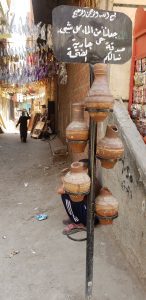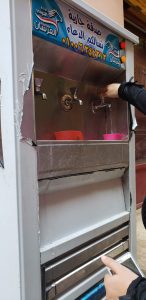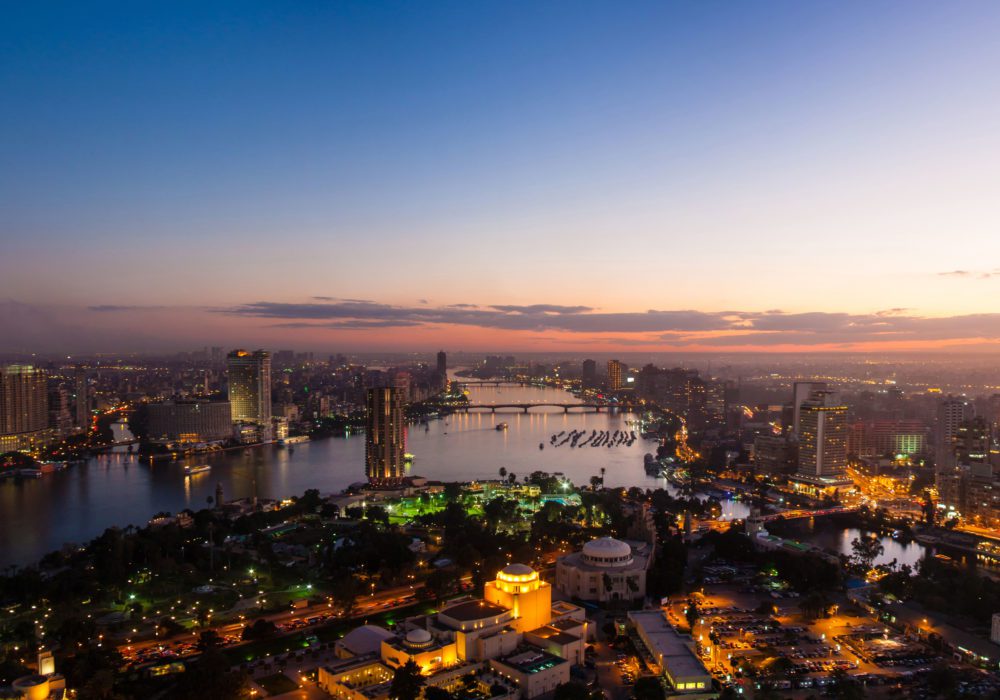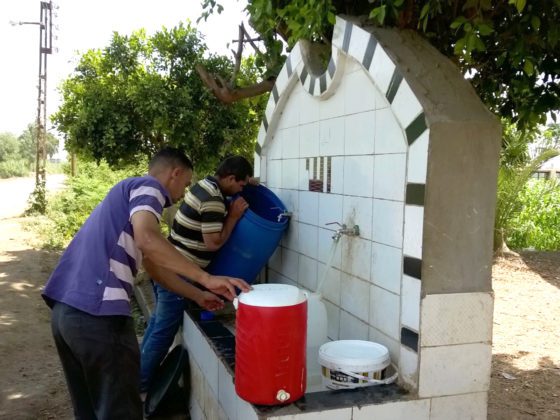In the face of increasing heat in the Middle East, residents of the informal area of Ezbet Khairallah (or Ezba) in Cairo, Egypt draw on longstanding practices of water sharing in the form of the sabil. Sabils are charitably-endowed water fountains that range from simple earthenware pitchers that cool water through evaporation to elaborate marble buildings. Many modern sabils take the forms of insulated water jugs and mechanized water dispensers.
The city of Cairo was once renowned for having combination sabil- kuttab, which were charitable water fountains combined with Quranic schools. Creating a sabil gathers merits accrued with God, and those merits can be shared by those who participate in maintenance. Merits are often passed on through a dedication to the memory of a departed loved one. As such, a sabil is both a gesture toward the afterlife and a commitment to the wellbeing of one’s current community – “a bodily need met with a spiritual response,” as one resident of the area told me.
Material, financial and moral systems intersect in the creation and maintenance of sabils, making them a particularly rich location to explore the changing history of water systems in the urban landscape. Sabils elucidate the history of Ezba’s development from the early years of a small informal settlement in the 1970 to one of Cairo’s largest informal areas.
Residents report that there had been few sabils in Ezba before the large-scale connection of “Do-It-Yourself” pipes tapped into municipal water supplies some twenty years previously. Few people could afford the time or effort of hand-carrying water from neighboring areas or purchasing it from the infrequent rounds of informal water-sellers only to give much of it away. It was common during that time, however, for residents to knock on a door and ask for a glass of water from a nearby house as they passed through the area.
As Ezba developed, and self-made water connections proliferated, a small number of sabils were established, primarily at mosques and in front of businesses. Many of these were earthenware pots, either small handheld ollel or larger zeer, which were relatively inexpensive and produced in a neighboring informal area. Children whose homes did not have a refrigerator would stop by to fill a water bottle on their way to school, mothers with small children and men on their way to and from work would pause to drink cool water. Sabils were often set up to serve multiple beneficiaries, with a bowl placed below to provision local cats, dogs and insects from the water that “sweats” from earthenware containers.
Another small wave of sabil creation happened in the mid 2010’s after the Cairo Governate installed a sewage network and formal piped water connections, reducing water contamination from leaky pipes and seeping septic tanks and improving water pressure to the area. This wave added a number of mechanized water coolers, referred to locally as coldaire, which required electricity and piped supply lines.
During ethnographic research in Ezbet Khairallah over the summer 2018, residents noted that there had been a dramatic multiplication in the number of sabils in the area over the last two years. They attributed this proliferation to extreme temperature increases over the last several summers and the coincidence of the holy month of Ramadan, during which observant Muslims abstain from eating and drinking from sunrise to sunset, falling during this time.[1]
The creators of several of these newly-established sabils recounted having heard of deaths from heat exhaustion and recalled their own experiences of thirst as they moved through the urban landscape. Others pointed to the nature of their street as particularly hot (unshaded), long, dry (without other sabils nearby) or busy (a main thoroughfare, or a location with many workshops) as reasons for their choice. This intersected with personal stories, as some families and small business owners who experienced the loss of a loved one transitioned a zeer or coleman water jug from personal use to sabil, changed from occasional providers of water to dedicated sabil-keepers, or upgraded from one form of sabil to another.
Many sabil-keepers paid particular attention to the quality of the water being provided, adding cut fruit, fresh mint or rosewater to a zeer, and tending to coleman water jugs by storing and washing them overnight. Some added frozen bottles of water at the start of each day. Ramadan provided a few sabil-keepers with the impetus to extend this by filling coleman-style sabils with tamer juice for the breaking of the fast.
In these and other ways, residents of Ezbet Khairallah have used longstanding practices of water sharing to manage the intensification of summer heat in their urban environment and to maintain the quality of life in their neighborhood.
—
Tessa Farmer is Assistant Professor in the Middle Eastern and South Asian Languages and Cultures Department and the Global Studies Program at the University of Virginia. Professor Farmer is working on a book entitled “Water at the Threshold: The Production of Ambiguity through Infrastructure in Cairo”. Her related work explores how lower-income residents of Cairo obtain sources of potable water and deal with the ramifications of sewage in their urban ecology.
[1] Because the Islamic calendar is lunar the month of Ramadan shifts seasons.
Phots provided by Tessa Farmer









